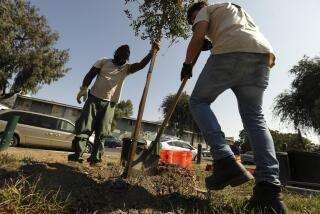Bird Welfare Causes Flap Over Pruning
Noting an increase in the number of wild birds in need of shelter, the president of the Wildlife Waystation has suggested the city suspend tree trimming in the spring, but city officials say the pruning is needed at that time to reduce safety hazards to people.
Martine Colette said her animal refuge receives hundreds of homeless hatchlings each spring, often delivered by tree-trimming crews from Burbank, Los Angeles and Santa Clarita. The birds’ nests--which include wrens, hummingbirds and sparrows--often topple out of the trees after the foliage is cut.
“If you’re dealing with a sparrow, some people might not think it’s a devastating impact. The sparrow it happened to is going to consider it devastating,” Colette said. “At one time, out of one tree out of Burbank, we had upward of 27 nests come in.
“It would be a lot easier if someone did not trim trees in the spring, when all the baby birds were unable to fly. It would be nice if the trees were trimmed in January.”
But city officials said spring pruning must continue to ensure human safety. Oscar Suquette, tree surgeon supervisor for the Los Angeles Department of Public Works, said budget cuts have reduced his Valley work crews to emergency trimming.
“Most of the trimming we do now is geared to safety. Most of our requests for trimming are generated by the public,” Suquette said. “There may be a potential public hazard due to fire.”
In Santa Clarita, city budget cuts of 54% for tree-trimming squads will limit pruning next spring to emergency situations only, said city arborist Ray Miramontez.
Jan Bartolo, deputy director for park services for the city of Burbank, said work crews already do their best to avoid nests in the 10,000 to 15,000 trees trimmed in that city each year, but any delay could create even more human hazards.
“We have code limitations that require trimming during periods of Santa Ana winds, general hazards, and when there are branches hanging down,” Bartolo said. “Just from the standpoint of how many trees we have to maintain, we’re just not in a position to let those months go by without doing anything.”
More to Read
Sign up for Essential California
The most important California stories and recommendations in your inbox every morning.
You may occasionally receive promotional content from the Los Angeles Times.










